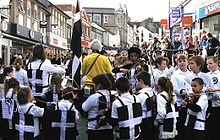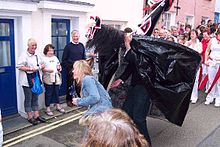- Cornish festivals
-
The cultural calendar of Cornwall is punctuated by numerous historic and community festivals and celebrations. In particular there are strong links between parishes and their patronal feast days (which are often days not directly linked to official church patronal celebrations). There is also a tradition of holding celebrations associated with tin mining and fishing.
Contents
Modern community festivals
Since the 1980s there has been a development of community based festivals in Cornwall often named after a famous local resident. These have included Murdoch day in Redruth, the Daphne du Maurier Festival in Fowey, Trevithick Day in Camborne and the Montol Festival in Penzance. Other modern festivals include, Falmouth oyster festival, Newlyn fish festival, Lowender Peran in Perranporth, Dehwelans Kernow and many more.
In Moonta, South Australia, the Kernewek Lowender (Cornish for "Cornish happiness") is the largest Cornish festival in the world and attracts tens of thousands of visitors each year.[1]
References
Historic festivals
The following list is of festivals celebrated past and present in Cornwall which can be traced back over 100 years or more, often these celebrations have considerable antiquity. These have been classified separately to the above because they form a part of a Cornish indigenous culture. There have been attempts and successes to revive these celebrations where they have fallen into disuse. Today many of these ceremonies are kept alive by members of the Federation of Old Cornwall Societies.
† = Parish feast day
Historic festivals and feast days of Cornwall Name Location Current Status Date Allantide Throughout Cornwall Celebrated in some parts of West Cornwall - Largely replaced by Halloween 31 October Golowan † Throughout Cornwall in particular Penzance Revived in various forms 1920s, 1935, 1990 Around the 23rd of June Midsummer Hilltop Bonfires Throughout Cornwall in particular Kit Hill, Carn Brea, Castle An Dinas Revived in various forms from 1930 23 June Furry dance † Helston Continuously celebrated with a short break in the Victorian era May 8 unless a Monday or Sunday then Saturday before. 'Obby 'Oss festival Padstow Still celebrated Around May 1st St Piran's Day † Throughout Cornwall Originally a miners' holiday now Cornwall's national day March 5 Nickanan Night also called Peasen Monday Throughout Cornwall Unknown - not publicly celebrated Shrove Monday Tom Bawcock's Eve Mousehole Continuously celebrated before World War II and revived in the 1950s 23 December Picrous Day East Cornwall Still celebrated in Luxulyan Second clear Thursday before Christmas Chewidden Thursday West Cornwall Unknown - Not publicly celebrated First clear Thursday before Christmas Madron Feast † Madron, Heamoor & formerly Penzance Still celebrated Advent Sunday and Monday St Just Feast † St Just in Penwith Still celebrated First Sunday and Monday in November West Cornwall May Day celebrations West Cornwall Revived since 2001 in St Ives and since 2008 in Penzance May the 1st Guise dancing Throughout Cornwall Still practised in some places including the Montol Festival in Penzance Christmas through to Twelfth Night and Plough Monday Paul Feast † Paul, Mousehole and Newlyn Continuously celebrated Sunday nearest 10 October and week following Sennen Feast † Sennen Still celebrated Advent Sunday Crying The Neck and Guldize Throughout Cornwall Still celebrated September Bodmin Wassail Bodmin Still celebrated New Twelfth Night (6 January) Knill Ceremony St Ives Still celebrated (started 1801) 25 July (St James Day every 5 years) St Keverne Feast † St Keverne Still celebrated Sunday nearest the 18th of November St Breward Feast † St Breward Still celebrated Sunday nearest 22 February St Day Feast † St Day, Carharrack Still celebrated End of June St Buryan Feast † St Buryan Still celebrated Sunday nearest the 13th of May Mevagissey Feast † Mevagissey Still Celebrated - Related to Golowan Around 29 June (St Peters Day) Towednack Cuckoo Feast † Towednack Still celebrated Around 28 April Goldsithney Charter Fair Goldsithney Still celebrated St James Day (Old Style) 5 August Zennor Feast † Zennor Still celebrated Sunday nearest the 6th of May Porthleven Petertide celebrations † Porthleven Still celebrated; Related to Golowan Near June 29 Gulval Feast † Gulval Still celebrated Near 6 June St Ives Feast (Feast Monday) † St Ives Still celebrated Sunday and Monday nearest the 3rd of February Hurling the Silver Ball St Columb Major Still celebrated Shrove Tuesday and then again on the Saturday eleven days later Mawgan Feast † Mawgan-in-Meneage Still celebrated Near June the 8th Mullion Feast † Mullion Still celebrated Sunday nearest 6 November Camborne Feast † Camborne Still celebrated Near 15 November Sancreed Feast † Sancreed Still celebrated (Patronal church service) Early June St Endellion Feast † St Endellion Still celebrated (Patronal church service) Sunday nearest May Bank Holiday St Stythians Feast † Stithians Still celebrated; Agricultural show held on the following Monday Sunday closest to 10 July St Allen Feast † St Allen Still celebrated but unknown to what extent 22 February (Traditionally Rogation Sunday) Bodmin Riding Bodmin Still celebrated as part of Bodmin Heritage and Riding festival Late June or early July Morvah Fair Morvah / West Cornwall No longer celebrated but Morvah Pasty Day takes place on the same date, claimed by some to be the largest Lughnasadh celebration outside Ireland August 1 St Erth Feast † St Erth Unknown October 31 Ludgvan Feast† Ludgvan Still celebrated Monday and Sunday nearest 29 January St Hilary Feast† St Hilary, Cornwall Still celebrated Mid - January Davidstow Feast† Davidstow Still celebrated March 1 Gunwalloe Feast† Gunwalloe Still celebrated March 3 Porthleven Feast† Porthleven Still celebrated February 22 St Kew Feast† St Kew Still celebrated February 8 References
- Charles Henderson "Celtic Kalendar: giving the feast days of most of the parishes in the Diocese" in: Cornish Church Guide (1925) Truro: Blackford; pp. 9–16
Culture of Cornwall Symbols 
Festivals Sports Cuisine Arts Music Cornish bagpipes · Brenda Wootton · Gwenno Saunders · Fisherman's Friends
Folk songsLanguage Folklore Beast of Bodmin · Blunderbore · Bucca · Cruel Coppinger · Knocker · King Arthur · Lyonesse · Owlman · Piskie
Organisations Cornwall portal Categories:- Cornish culture
- Festivals in Cornwall
Wikimedia Foundation. 2010.


